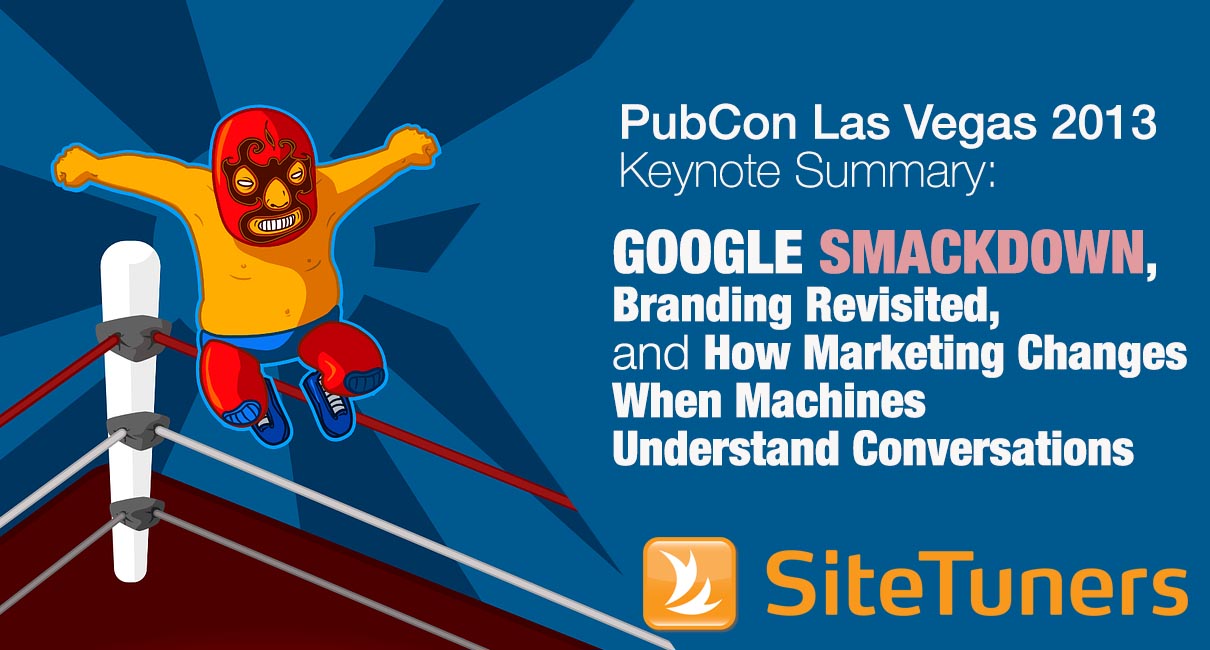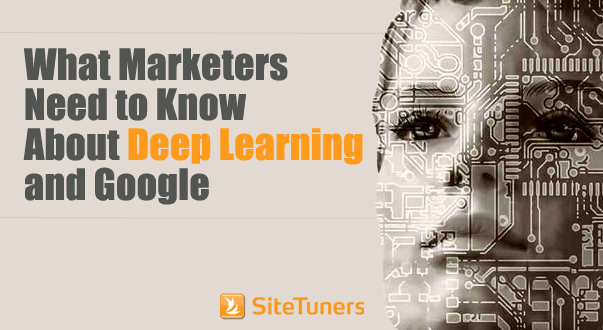
Still, PubCon 2013 might be remembered for something else – it will probably go down in history as the Jason Calacanis and Matt Cutts show.
A Tale of Two Keynotes: Jason vs. Matt
.@mattcutts the best strategy might be an apology, admission you haven’t been a great partner & some ideas on how @google could be better.
— jason 🦄 (@Jason) October 22, 2013
It all started with Jason Calacanis’s keynote – he discussed where media is now, and touched on Google’s footprint in an array of industries. He noted the changes in TV, radio, digital, and publishing ad spend, and throughout the talk, he indicated that Google is winning key battles that will enable them to grow – but he notes that they are not a good partner for growing your business.
Matt Cutts of Google, of course, was slated to give the day 2 keynote – which led to reactions like this:
@Jason @mattcutts This should be good 🙂
— Bruce Cat (@brucecat) October 22, 2013
@mattcutts @Jason I got fistfuls of popcorn over here. [No metatags or hidden text. Just popcorn.]
— Chris Sacca (@sacca) October 22, 2013
Jason Calacanis’s Keynote: the State of the Media
Jason began his talk by noting that 2012 digital ad revenue was higher than those for magazines, radio, or newspapers, but still just half of TV ad revenue.
TV, Radio, and Film
He expects digital to eventually bite into more of the TV revenue – live television lost 25% of the audience to streaming and recorded between 2009 and 2013, and Internet TV is becoming cheaper (Apple TV at $300 upon launch, $99 a while later, and now, the Chromestick at $35). Google Fiber is expanding, and he notes that the disruption is likely to continue.
Radio is changing, with Pandora as the most popular channel now, and it’s mostly used on cars, buses, trains, and at home. As for film, DVD sales will continue to drop, but videostreaming offers hope.
Publishing, Magazines, and Newspapers
Jason observes that eBooks now account for 23% of book sales, and they are likely to outpace hardcovers in the next 5 years. As for magazines, they are selling half as many ads, and the industry is reeling. The major newspapers have made the adjustments for digital: the New York Times and the Wall Street Journal both have plenty of online subscribers. Jason also notes that moves like Jeff Bezos of Amazon buying the Washington Post means journalism is in capable hands.
Advertising
In 2013, search still leads the charge for ad spend:
-
- Search: 46%
-
- Display/banner: 21%
-
- Classifieds: 7%
-
- Mobile: 9%
Jason notes that some publishers now see Google as the enemy. Google is competing for the same revenue with some of their partners, and they are not a good partner.
The hashtag for the next 10 years: #googlewinseverything
— jason 🦄 (@Jason) October 22, 2013
Matt Cutts’s Keynote: State of the Index
Smackdown or no smackdown, Matt Cutts is a superb speaker, and he begins his keynote by talking about some of the big changes within Google, like delivering information before a search is made, algorithms understanding basic conversation language, and the company finding deeper insights about the relationships between things.
Moonshots
Try this: ask Google via your phone what the weather in your area will be like. Once Google presents you weather data, ask it again: “what about on Sunday?” The search engine will understand that you’re still talking about the weather, and will present you with updated results accordingly. Matt and the rest of the team at Google consider this, “Conversational Search,” one of the moonshots that the company is working on – big things that change the game, rather than incremental improvements. (Sidenote: at the beginning of the year, Wired had an interview with Larry Page, CEO of Google, specifically on moonshots, and it’s well worth the read.)
Matt also talked about some of the other moonshots they are working on:
-
- Knowledge Graph and Deep Learning– the company is understanding the relationships between words, treating words as “things” rather than “strings,” so connections can be made between them to improve search.
-
- Google Now – Google is attempting to bring users relevant information before a search is made, like indicating that you have to leave to make an appointment if they have your calendar information.
Algorithm Changes and Web Spam
After covering the broad strokes, Matt tackled the algorithm changes:
-
- Hummingbird – an engine replacement that “understands” which words are not as important. Matt’s gives an example: if you ask Google, “what is the capital of Texas, my dear,” it will know that “my dear” is not as important.
-
- Panda Softening – letting the “grey” areas recover some of their ranking from the content quality algorithm change
-
- Detecting and Boosting Authorities – letting the search engine “recognize” who the experts in the fields are, so that if people are likely to recognize the experts in real life, Google will also reflect this in the results
-
- Smartphone Ranking – search reflecting results that tie into things like device properties, so if your phone can’t display Flash, sites that have Flash are less likely to rank
Matt also covered some of the recent changes to web spam – how when they released Penguin 2.0, spammers laughed it off, and Google basically “turned the knob higher.” They also started penalizing sites that pass link equity through advertisements, and are taking more action on spam networks.
“When spammers are threatening me bodily harm, my team is doing their job.” @mattcutts #pubcon
— Jennifer Slegg (@jenstar) October 23, 2013
The Future of Search and Tips to Prepare
Going back to the broad stuff, Matt covered the three big things that Google’s looking at:
1. Machine Learning – Google’s mission is to organize the world’s information and make it universally accessible, and that doesn’t include the words “search engine.” They are using machine learning to add more value for users, like to tell whether it’s going to rain in your area.
2. Mobile – Smart phone traffic is growing at a tremendous rate. Matt cites YouTube as an example:
a. In 2011 6% of YouTube traffic was mobile
b. In 2012, that shot up to 25%
c. In 2013, 40% of YouTube use is from mobile phones
3. Social Identity and Authorship – Google doesn’t necessarily boost rankings if you have a lot of likes, retweets, or +1s, but long term, having good social signals is a reflection of authority. Since social is “mirroring” the fact that you are someone worth listening to, search engines will listen to this as well.
If you’re looking for tactical tips:
-
- Get ready for mobile – think about m., responsive web design, remove Flash, and otherwise prepare
-
- Prepare to markup your forms with requestAutocomplete() for one-click fill outs, and remove the friction
-
- Ad heavy pages – increased penalties coming, so improve the user experience for your site
-
- Authorship – Google’s reducing the number of authors shown by 15% to improve quality
-
- Rich snippets – this will now depend on the quality of the web site
-
- Javascript – common JavaScript can now be read by Google better
Is Google a Good Partner?
Matt asked the crowd whether to get into the comments that Jason made, and – as you could probably guess – the crowd wanted to get into it. Matt began by saying that he has a ton of respect for Jason, and he proceeded to talk about the “Google as a partner” context. Part of Jason’s issue with Google was how they rolled out Panda, Google’s algorithm against content farms, and how the change really hurt sites like Mahalo, Jason’s company.
Matt explained that Panda couldn’t have rolled out slowly, as Jason suggests, and that content farms were a serious issue for Google back in the day.
#pubcon audience wants a fight between @jason and @mattcutts 🙂 so Matt responds with some hilarious spam examples pic.twitter.com/DEh6ESm95P
— Promodo (@promodo_en) October 23, 2013
He met with Jason a few years back to discuss the issue, but the two ultimately ended up at an impasse. Ultimately, the algorithm found that in aggregate, Mahalo was not a quality site.
Scott Stratten’s Keynote: Unmarketing
Day 3’s keynote carried none of the controversy from the first two, but was every bit as entertaining.
Great read about @unmarketing at #pubcon– http://t.co/HjAyn7ZhL3 .Authenticity+immediacy are both important & @RitzCarlton story-priceless!
— Maria Elena Duron #MarketingCoachMaria (@mariaduron) October 26, 2013
Scott talked about the Ritz Carlton’s two brand stories. The first is what the brand team does – which way the lion in the logo is facing, and other marketing and brand team calls. The second is Joshie, a stuffed giraffe a guest family left behind.
The toy was left behind at the Ritz, and the kid who owned it started panicking. To keep things from getting worse, the dad told him that Joshie was on extended vacation, and he called the hotel to ask if they had spotted the toy.
What happened next is now documented very well, and still a great example of customer service. The staff of the Ritz Carlton hotel took photos of the toy as he was taking a vacation – sitting by the pool, getting a spa, making friends with other toys – and sent the photos along with Joshie to the family.
That’s what Scott notes is a brand experience: exceptional customer service. Every email, every tweet or unanswered phone call, every employee interaction, good or bad, is part of marketing.
He notes that there are two things people remember about a company: the last interaction with the brand, and their most extreme, good or bad. Likewise, he talks about the things that make social work: being worth talking about, responding immediately, and being authentic.
The other big thing Scott talked about is how technology gets applied by marketers. He cites QR codes as a common example of what gets used the wrong way – QR codes on billboards when people aren’t even supposed to actively use their phone while driving, QR codes on emails when links should really be used, QR codes on pet tags instead of phone numbers.
Takeaways from Pubcon: Preparing for 2014
As we all get ready to close out the year, there are a few things Pubcon makes clearer for marketers.
1. If your business model is dependent on Google staying largely the same, now is a serious time to review it. Keywords (not provided) is only the beginning – as Google gets more and more into machine learning, and it’s going to get even better at providing answers, sometimes right there on the results page. If you want to perform well, you better be answering questions that algorithms cannot answer.
2. If Google is your only means of acquiring visitors, it’s time for a change. Diversify, get visitors from other channels, and maintain relationships with existing prospects and customers via email and social.
3. The marketing team isn’t responsible for the brand. Everyone at the company is responsible for the brand.
4. The mobile numbers for YouTube may not be in line with what you’re seeing, but if you don’t have a plan yet and a budget for mobile yet, you better start rethinking that.
5. Algorithms are getting better at “mirroring” real world popularity and authority. If you don’t have authorship tags set up yet, start setting those up. If you do, it’s time to double-down on your niche, so you get recognized as an expert. And as Scott notes, if you want word of mouth, do stuff worth talking about.
PubCon 2014 has big shoes to fill – game on.
Work with the best!Kickstart your optimization with a 90-minute Website Review from the pioneers in conversion rate optimization. Our CRO experts at SiteTuners can help diagnose your website from a conversion and usability perspective. |



